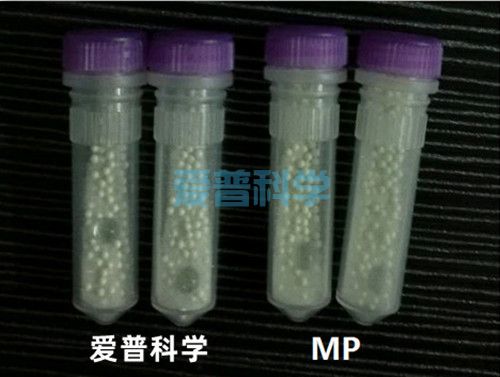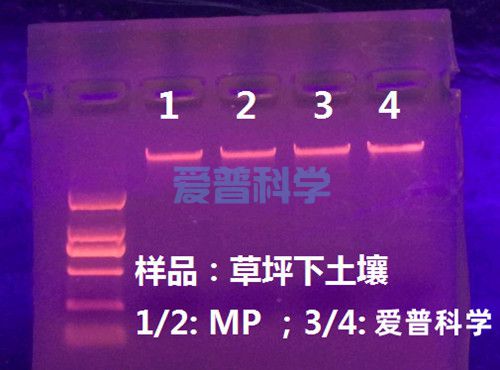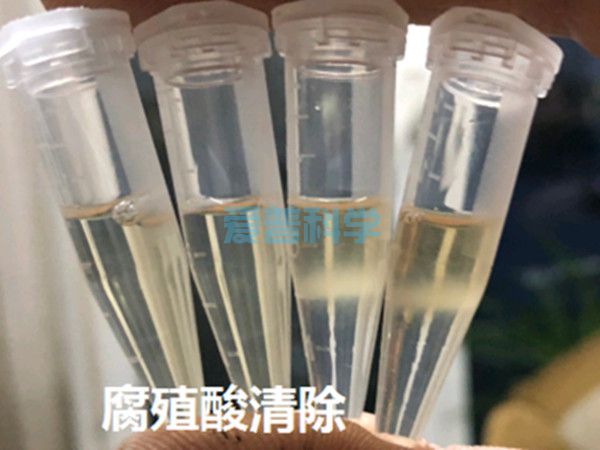咨询热线
010-62872425

订货时间:周一至周五(9:00-17:30)
订货电话:010-62872425
订货Q Q: 247937283、1098867025
订货邮箱:order@ipresci.com
订单模板:批量订单.xls


爱普科学/OD203/AipBest土壤DNA提取试剂盒(珠磨法)是综合MP公司的土壤DNA提取试剂盒产量高和Mobio公司的土壤DNA提取试剂盒纯度高的优点研制而成,采取MP公司完全一致的研磨管(3种研磨珠混合)方案,可以处理更大量的样本,可以直接使用MP研磨管一样的珠磨仪器和参数。独有的去腐殖酸技术可以完美去除各种腐殖酸和杂质的影响,提取的DNA纯度高,可以直接用于下游PCR反应。
爱普科学生产的该升级款试剂盒的前面操作步骤和MP完全一样,无需更换仪器和参数等,连研磨管都和MP一样,完全在MP的基础上进行优化改进的升级产品,提取复杂的土壤样本DNA纯度更高!用于下游PCR反应的扩增效率会更好!




AipBest Soil Genome DNA Extraction Kit(Bead Beating)
◆ Description
The AipBest Soil Genome DNA Extraction Kit quickly and efficiently isolates PCR-ready genomic DNAdirectly from soil samples in less than 40 minutes. Designed for use with Beads-Beating device such as the FastPrep® Instruments from MP Biomedicals,soil organisms population are easily lysed within 40 seconds. Samples are placed into 2.0 ml tubes containing 3 kinds of beads, a mixture of ceramic and silica particles designed to efficiently lyse all soil organisms including historically difficult sources such as eubacterial spores and endospores, gram positive bacteria, yeast, algae, nematodes and fungi.
The kit uses a novel and proprietary method to remove high humic acid content including difficult soil types such as compost, sediment, and manure.The isolated DNA has a high level of purity allowing for more successful PCR amplification of organisms from the sample. PCR analysis has been performed to detect a variety of organisms including bacteria (e.g. Bacillus subtilis, Bacillus anthracis), fungi (e.g. yeasts, molds), algae and Actinomycetes (e.g. Streptomyces).
◆ Important consideration before use
The fill volume in the bead tube after the addition of the Sodium Phosphate and MT Buffers to the sample should allow sufficient air space in the sample tube for efficient FastPrep® Instrument processing. MP Biomedicals recommends using 500 mg of starting material as long as there is between 250 - 500 μl of empty space in the tube. Sample loss or tube failure may result from overfilling the bead tube. The bead tube caps must be secure, but not over-tightened, to prevent sample leakage. If the sample is too large for processing in a single tube, divide the sample and process using multiple tubes. The kits have been rigorously tested in the FastPrep® Instrument. A single 40 second run at a speed setting of 6.0 in the FastPrep® Instrument is sufficient to lyse almost all samples. If the user experimentally determines that additional processing time is required, the sample should be incubated on ice in the bead tube for at least 2 minutes between successive FastPrep® Instrument homogenizations to prevent overheating the sample and tube.
If you use other bead beater device, please follow instruction manual from manufaturer to set appropriate parameter for good performance.
◆ Procedure
Note:Before the first use, add the indicated amount of ethanol into PQ solution bottle, Buffer WB bottle, mix well, and mark the bottle with a check.
1. Add up to 500 mg of soil sample to a Bead Tube.
2. Add 980 μl Sodium Phosphate Buffer to sample in Bead Tube. Gentle votex to mix. Add 120 μl MT Buffer.
Note: Check MT Buffer. If MT Buffer is precipitated, heat solution to 60°C until dissolved before use.
3. Homogenize in the FastPrep® Instrument for 40 seconds at a speed setting of 6.0.
4. Centrifuge at 12,000 x g for 5minutes to pellet debris.
5. Transfer supernatant to a clean 2.0 ml centrifuge tube. Add 250μl PPS Solution and mix by shaking the tube by hand 10 times. Incubate at 4°C for 5 minutes.
6. Centrifuge tubes at 10,000 x g for 3 minute at room temperature. Avoiding pellet, transfer up to, but no more than, 900 μl of supernatant to a clean 2 ml centrifuge tube.
7. Add 300 μl of IRS Solution(1/3 volume) and vortex briefly. Incubate at 4°C for 5 minutes.
8. Centrifuge tubes at 10,000 x g for 1 minute at room temperature. Avoiding pellet, transfer the supernatant into a clean 5 ml centrifuge tube.
9. Add 1.5 volumes of PQ Solution to the cleared supernatant and mix by pipetting.
Example: To 1100 μl lysate add 1650 μl PQ Solution. Reduce the amount of PQ Solution accordingly if less supernatant is recovered. A precipitate may form after the addition of ethanol but this will not affect the procedure.
Note: Ensure ethanol has been added to PQ Solution.
Note: It is important to pipet PQ Solution directly onto the cleared supernatant and to mix immediately.
10. Load approximately 700 μl mixture onto Spin Filter(sitting in collection tube) and centrifuge at 10,000 x g for 1 minute at room temperature. Discard flow through. Load another 700 μl and repeat untill all remaining mixture is loaded on Spin Filter.
Note: A total of 4-5 loads for each sample processed may be required.
11. Add 600 μl of Buffer WB to Spin Filter and centrifuge at 10,000 x g for 30 seconds at room temperature. Discard flow through. Repeat Step 11 with another 600 µl Buffer WB.
Note: Ensure ethanol is added to Buffer WB.
12. Centrifuge Spin Filter at 13,000 x g for 2 minute at room temperature to dry the Spin Filter..
13. Carefully place Spin Filter in clean 1.5 ml centrifuge tube. Avoid splashing any Buffer WB onto Spin Filter. Add 100 µl of Elution Buffer (Optional: pre-warm the water to 70–90°C will increase the DNA yield) to the center of the column membrane. Incubate at room temperature for 3-5 min, and centrifuge at 13,000 x g for 1 min to elute the DNA.
Note: Use smaller volume(minimum 30µl) of Elution Buffer will obtain higher concentration.
Optional: Put eluate back to the Spin Column to repeat elution once. This increases concentration of DNA about 10-15%.